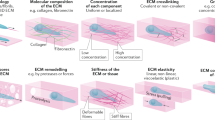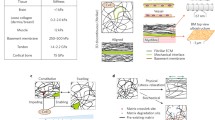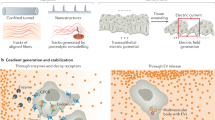Cell migration is an important and fundamental process. It underlies embryonic development, immune responses, and the repair and regeneration of damaged tissues. Impairments to migration are linked with many important diseases, such as tumor metastasis. The direction of migration can be regulated both by extracellular and intracellular factors. In the case of chemical extracellular factors, the directional migration of cells is called chemotaxis. This review presents a current model of the mechanisms selecting the direction of movement of mesenchymal cells, and analogies and comparisons are made with the mechanisms of chemotaxis in well studied ameboid cells.
Similar content being viewed by others
Abbreviations
- GDP:
-
guanosine diphosphate
- GTP:
-
guanosine triphosphate
- MAPK:
-
mitogen-activated protein kinase
- NADPH:
-
reduced nicotinamide adenine dinucleotide phosphate
- cAMP:
-
cyclic adenosine monophosphate
- cGMP:
-
cyclic guanosine monophosphate
- Akt/PKB:
-
protein kinase B also known as Akt
- DAG:
-
diacylglyceride
- ERK1/2:
-
extracellular signal-regulated kinase)
- fMLP:
-
N-formylmethionyl-leucyl-phenylalanine
- GPCR:
-
G-protein coupled receptors
- Grb2:
-
growth factor receptor-bound protein 2
- IP3 :
-
inositol triphosphate
- LEFI:
-
the “local excitation global inhibition” model
- mTORC2:
-
mammalian target of rapamycin complex 2
- PDGF:
-
platelet-derived growth factor
- PI3 kinase:
-
phosphatidylinositol-3′-kinase
- PI-3,4-P2 :
-
phosphatidylinositol-(3,4)-biphosphate
- PI-4,5-P2 :
-
phosphatidylinositol-(4,5)-biphosphate
- PIP3 :
-
phosphatidylinositol-(3,4,5)-triphosphate
- PLA2:
-
phospholipase A2
- PTB domain:
-
phosphotyrosine-binding domain
- PTEN:
-
phosphatase and tensin homolog deleted on chromosome 10
- RTK:
-
tyrosine kinase receptor
- Ras:
-
a small GTPase
- SH2 domain:
-
Src homology domain)
- SHIP:
-
Src homology 2 (SH2)-containing phosphatase
- Sos:
-
guanine nucleotide exchange factor for small Ras (contraction of Son of Sevenless)
- Src:
-
tyrosine kinase (name derived from “sarcoma”).
References
A. V. Vorotnikov, “Chemotaxis: movement, direction, control,” Usp. Biol. Khim., 51, 335–400 (2011).
V. A. Tkachuk, P. A. Tyurin-Kuz’min, V. V. Belousov, and A. V. Vorotnikov, “Hydrogen peroxide as a new second messenger,” Biol. Membrany, 29, 21–37 (2012).
P. A. Tyurin-Kuz’min, K. M. Agaronyan, Ya. I. Morozov, et al., “NAD(P)H oxidase regulates EGF-dependent cell proliferation via a mechanism distinct from ERK1/2 MAP kinase activation,” Biofizika, 55, 1048–1056 (2010).
S. J. Annesley and P. R. Fisher, “Dictyostelium discoideum – a model for many reasons,” Mol. Cell. Biochem., 329, 73–91 (2009).
Y. Arai, T. Shibata, S. Matsuoka, et al., “Self-organization of the phosphatidylinositol lipids signaling system for random cell migration,” Proc. Natl. Acad. Sci. USA, 107, 12,399–12,404 (2010).
A. Bellacosa, J. R. Testa, S. P. Staal, and P. N. Tsichlis, “A retroviral oncogene, akt, encoding a serine-threonine kinase containing an SH2-like region,” Science, 254, 274–277 (1991).
L. Bosgraaf and P. J. Van Haastert, “Navigation of chemotactic cells by parallel signaling to pseudopod persistence and orientation,” PLoS One, 4, e5252 (2009).
L. Bosgraaf and P. J. Van Haastert, “The ordered extension of pseudopodia by amoeboid cells in the absence of external cues,” PLoS ONE, 4, e5253 (2009).
M. D. Brown and D. B. Sacks, “Compartmentalised MAPK pathways,” Handb. Exp. Pharmacol., 205–235 (2008).
H. Cai, “Hydrogen peroxide regulation of endothelial function: origins, mechanisms, and consequences,” Cardiovasc. Res., 68, 26–36 (2005).
H. Cai, S. Das, Y. Kamimura, et al., “Ras-mediated activation of the TORC2-PKB pathway is critical for chemotaxis,” J. Cell Biol., 190, 233–245 (2010).
L. C. Cantley, “The phosphoinositide 3-kinase pathway,” Science, 296, 1655–1657 (2002).
L. A. Cary, R. A. Klinghoffer, C. Sachsenmaier, and J. A. Cooper, “SRC catalytic but not scaffolding function is needed for integrin-regulated tyrosine phosphorylation, cell migration, and cell spreading,” Mol. Cell. Biol., 22, 2427–2440 (2002).
L. Chen, M. Iijima, M. Tang, et al., “PLAS and PI3K/PTEN pathways act in parallel to mediate chemotaxis,” Dev. Cell., 12, 603–614 (2007).
J. den Hertog, A. Groen, and T. van der Wijk, “Redox regulation of protein tyrosine phosphatases,” Arch. Biochem. Biophys., 434, 11–15 (2005).
J. M. Denu and K. G. Tanner, “Specific and reversible inactivation of protein tyrosine phosphatases by hydrogen peroxide: evidence for a sulfenic acid intermediate and implications for redox regulation,” Biochemistry, 37, 5633–5642 (1998).
P. Devreotes and C. Janetopoulos, “Eukaryotic chemotaxis: distinctions between directional sensing and polarization,” J. Biol. Chem., 278, 20,445–20,448 (2003).
P. Devreotes and S. H. Zigmond, “Chemotaxis in eukaryotic cells: a focus on leukocytes and Dictyostelium,” Annu. Rev. Cell. Biol., 4, 649–686 (1988).
M. C. Frame, “Src in cancer: deregulation and consequences for cell behaviour,” Biochem. Biophys. Acta 1602, 114–130 (2002).
S. Funamoto, R. Meili, S. Lee, et al., “Spatial and temporal regulation of 3-phosphoinositides by PI 3-kinase and PTEN mediates chemotaxis,” Cell, 109, 611–623 (2002).
M. Geiszt and T. L. Leto, “The Nox family of NAD(P)H oxidases: host defense and beyond,” J. Biol. Chem., 279, 51,715–51,718 (2004).
E. Giannone, F. Buricchi, G. Raugeri, et al., “Intracellular reactive oxygen species activate Src tyrosine kinase during cell adhesion and anchorage-dependent cell growth,” Mol. Cell. Biol., 25, 6391–6403 (2005).
P. T. Hawkins, K. E. Anderson, K. Davidson, and L. R. Stephens, “Signalling through Class I PI2Ks in mammalian cells,” Biochem. Soc. Trans., 34, 647–662 (2006).
N. Hay and N. Sonenberg, “Upstream and downstream of mTOR,” Genes. Dev., 18, 1926–1945 (2004).
S. J. Heasman and A. J. Ridley, “Mammalian Rho GTPases: new insights into their functions from in vivo studies.” Nat. Rev. Mol. Cell. Biol., 9, 690–701 (2008).
P. A. Iglesias and A. Levchenko, “Modeling the cell’s guidance system,” Sci. STKE., re12 (2002).
M. Iijima and P. Devreotes, “Tumor suppressor PTEN mediates sensing of chemoattractant gradients,” Cell, 109, 599–610, (2002).
C. Janetopoulos and R. A. Firtel, “Directional sensing during chemotaxis,” FEBS Lett., 582, 2075–2085, (2008).
C. Janetopoulos, T. Jin, and P. Devreotes, “Receptor-mediated activation of heterotrimeric G-proteins in living cells,” Science, 291, 2408–2411, (2001).
C. Janetopoulos, L. Ma, P. N. Devreotes, and P. A. Iglesias, “Chemoattractant-induced phosphatidylinositol 3,4,5-trisphosphate accumulation is spatially amplified and adapts, independent of the actin cytoskeleton,” Proc. Natl. Acad. Sci. USA, 101, 8951–8956, (2004).
E. Karsenti, “Self-organization in cell biology: a brief history,” Nat. Rev. Mol. Cell. Biol., 9, 255–262, (2008).
J. Kwon, S. R. Lee, K. S. Yang, et al., “Reversible and inactivation of the tumor suppressor PTEN in cells stimulated with peptide growth factors,” Proc. Natl. Acad. Sci. USA, 101, 16,419–16,424, (2004).
T. Lammermann and M. Sixt, “Mechanical modes of ‘amoeboid’ cell migration,” Curr. Opin. Cell. Biol., 21, 636–644, (2009).
I. Lassing, F. Schmitzberger, M. Bjornstedt, et al., “Molecular and structural basis for redox regulation of beta-actin,” J. Mol. Biol., 370, 331–348, (2007).
D. A. Lauffenburger and A. F. Horwitz, “Cell migration: a physically integrated molecular process,” Cell, 84, 359–369, (1996).
S. R. Lee, K. S. Yang, J. Kwon, et al., “Reversible inactivation of the tumor suppressor PTEN by H2O2,” J. Biol. Chem., 277, 20336–20342, (2022).
J. Li, M. Stouffs, L. Serrander, et al., “The NADPH oxidase NOX4 drives cardiac differentiation: Role in regulating cardiac transcription factors and MAP kinase activation,” Mol. Biol. Cell, 17, 3978–3988, (2006).
L. Liu, S. Das, W. Losert, and C. A. Parent, “mMTORC2 regulates neutrophil chematoxis in a camp-and RhoA-dependent fashion,” Dev. Cell, 19, 845–857, (2010).
C. M. Lo, H. B. Wang, M. Dembo, and Y. L. Wang, “Cell movement is guided by the rigidity of the substrate,” Biophys. J., 79, 144–152, (2000).
T. Maehama and J. E. Dixon, “PTEN: a tumour suppressor that functions as a phospholipid phosphatase,” Trends Cell. Biol., 9, 125–128, (1999).
N. M. Mishina, P. A. Tyurin-Kuzmin, K. N. Markvicheva, et al., “Does cellular hydrogen peroxide diffuse or act locally?” Antioxid. Redox Signal, 141, 1–7, (2011).
M. Moes, J. Boonstra, and E. Regan-Klapisz, “Novel role of cPLA(2)alpha in membrane and actin dynamics,” Cell. Mol. Life Sci., 67, 1547–1557, (2010).
A. Narang, K. K. Subramanian, and D. A. Lauffenburger, “A mathematical model for chemoattractant gradient sensing based on receptor-regulated membrane phospholipid signaling dynamics,” Ann. Biomed. Eng., 29, 677–691, (2001).
P. Niethammer, C. Grabner, A. T. Look, and T. J. Mitchison, “A tissue-scale gradient of hydrogen peroxide mediates rapid wound detection in zebrafish,” Nature, 459, 996–999, (2009).
V. Niggli, “Signaling to migration in neutrophils: importance of localized pathways,” Int. J. Biochem. Cell. Biol., 35, 1619–1638, (2003).
M. Nishio, K. Watanabe, J. Sasaki, et al., “Control of cell polarity and motility by the PtdIns(3,4,5)P3 phosphatase SHP1,” Nat. Cell. Biol., 9, 36–44, (2007).
R. Pankov, Y. Endo, S. Even-Ram, et al., “A Rac switch regulates random versus directionally persistent cell migration,” J. Cell. Biol., 170, 793802, (2005.)
T. Pawson, G. D. Gish, and P. Nash, “SH2 domains, interaction modules and cellular wiring,” Trends Cell. Biol., 11, 504–511, (2011).
M. Postma and P. J. Van Haastert, “A diffusion-translocation model gradient sensing by chemotactic cells,” Biophys. J., 81, 1314–1323, (2001).
W. J. Rappel, P. J. Thomas, H. Levine, and W. F. Loomis, “Establishing direction during chemotaxis in eukaryotic cells,” Biophys. J., 83, 1361–1367, (2002).
A. J. Ridley, “Rho GTPases and actin dynamics in membrane protrusions and vesicle trafficking,” Trends Cell Biol., 16, 522–529, (2006).
A. J. Ridley, M. A. Schwartz, K. Burridge, et al., “Cell migration: integrating signals from front to back,” Science, 302, 1704–1709, (2003).
P. Rodriguez-Viciana, P. H. Warne, R. Dhand, et al., “Phosphatidylinositol-3-OH kinase as a direct target of Ras,” Nature, 370, 527–532, (1994).
A. San Martin and K. K. Griendling, “Redox control of vascular smooth muscle migration,” Antioxid. Redox Signal, 12, 625–640, (2010).
D. D. Sarbassov, S. M. Ali, D. H. Kim, et al., “Rictor, a novel binding partner of mTOR, defines a rapamycin-insensitive and raptor-independent pathway that regulates the cytoskeleton,” Curr. Biol., 14, 1296–1302, (2004).
D. D. Sarbassov, D. A. Guertin, S. M. Ali, and D. M. Sabatini, “Phosphorylation and regulation of Akt/PKB by the rictor-mTOR complex,” Science, 307, 1098–1101, (2005).
A. T. Sasaki, C. Janetopoulos, S. Lee, et al., “G protein-independent Ras/PI3K/F-actin circuit basic cell motility,” J. Cell. Biol., 178, 185–191, (2007).
I. C. Schneider and J. M. Haugh, “Quantitative elucidation of a distinct spatial gradient-sensing mechanism in fibroblasts,” J. Cell. Biol., 171, 883–893, (2005).
H. Seppa, G. Grotendorst, S. Seppa, et al., “Platelet-derived growth factor in chemotactic for fibroblasts,” J. Cell. Biol., 92, 584–588, (1982).
G. Servant, O. D. Weiner, E. R. Neptune, et al., “Dynamics of a chemoattractant receptor in living neutrophils during chemotaxis,” Mol. Biol. Cell., 10, 1163–1178, (1999).
A. Sorkin and M. von Zastrow, “Endocytosis and signaling: intertwining molecular networks,” Nat. Rev. Mol. Cell. Biol., 10, 609–622, (2009).
S. Srinivasan, F. Wang, S. Glavas, et al., “Rac and Cdc42 play distinct roles in regulating PI(3,4,5)P3 and polarity during neutrophil chemotaxis,” J. Cell. Biol., 160, 375–385, (2003).
K. F. Swaney, C. H. Huang, and P. N. Devreotes, “Eukaryotic chemotaxis: a network of signaling pathways controls motility, directional sensing, and polarity,” Annu. Rev. Biophys., 39, 265–289, (2010).
M. Ushio-Fukai, “Redox signaling in angiogenesis: role of NADPH oxidase,” Cardiovasc. Rev., 71, 226–235, (2006).
P. J. Van Haastert, “How cells use pseudopods for persistent movement and navigation,” Sci. Signal., 4, pe6, (2011).
B. Vanhaesebroeck, S. J. Leevers, G. Panayotou, and M. D. Waterfield, “Phosphoinositide 3-kinases: a conserved family of signal transducers,” Trends Biochem. Sci., 22, 267–272, (1997).
J. M. Vasiliev, “Cytoskeletal mechanisms responsible for invasive migration of neoplastic cells,” Int. J. Dev. Biol., 48, 425–439, (2004).
D. M. Veltman and P. J. van Haastert, “The role of cGMP and the rear of the cell in Dictyostelium chemotaxis and cell streaming,” J. Cell. Sci., 121, 120–127, (2008).
M. Vicente-Manzanares, X. Ma, R. S. Adelstein, and A. R. Horwitz, “Non-muscle myosin II takes center stage in cell adhesion and migration,” Nat. Rev. Mol. Cell. Biol., 10, 778–790, (2009).
M. von Zastrow and A. Sorkin, “Signaling on the endocytic pathway,” Curr. Opin. Cell. Biol., 19, 436–445, (2007).
M. C. Weiger, S. Ahmed, E. S. Welt, and J. M. Haugh, “Directional persistence of cell migration coincides with stability of asymmetric intracellular signaling,” Biophys. J., 98, 67–75, (2010).
M. C. Weiger, C. C. Wang, M. Krajcovic, et al., “Spontaneous 3-kinase signaling dynamics drive spreading and random migration of fibroblasts,” J. Cell. Sci., 122, 313–323, (2009.)
O. D. Weiner, P. O. Neilsen, G. D. Prestwich, et al., “A PtdInsP(3)-and Rho GTPase-mediated positive feedback loop regulates neutrophil polarity,” Nat. Cell. Biol., 4, 509513, (2002).
E. S. Welf, S. Ahmed, H. E. Johnson, et al., “Migrating fibroblasts reorient directionality by a metastable, PI3K-dependent mechanism,” J. Cell. Biol., 197, 105–114, (2012).
A. Wells, M. F. Ware, F. D. Allen, and D. A. Lauffenburger, “Shaping up for shipping out: PLCgamma signaling of morphology changes in EGF-stimulated fibroblasts migration,” Cell. Motil. Cytoskeleton., 44, 227–233, (1999).
M. P. Wymann and L. Pirola, “Structure and function of phosphoinositide 3-kinases,” Biochim. Biophys. Acta, 1436, 127–150, (1998).
Y. Xiong, C. H. Huang, P. A. Iglesias, and P. N. Devreotes, “Cells navigate with a local-excitation, global-inhibition-biased excitable network,” Proc. Natl. Acad. Sci. USA. 107, 17,079–17,086, (2010).
J. Xu, F. Wang, A. Van Keymeulen, et al., “Divergent signals and cytoskeletal assemblies regulate self-organizing polarity in neutrophils,” Cell, 114, 201–214, (2003).
M. B. Yaffe, “Phosphotyrosine-binding domains in signal transduction,” Nat. Rev. Mol. Cell. Biol., 3, 177–186, (2002).
M. Zhao, “Electrical fields in wound healing – An overriding signal that directs cell migration,” Semin. Cell. Dev. Biol., 20, 674–682 (2009).
Author information
Authors and Affiliations
Corresponding author
Additional information
Translated from Rossiiskii Fiziologicheskii Zhurnal imeni I. M. Sechenova Vol. 99, No. 3, pp. 294–312, March, 2013.
Rights and permissions
About this article
Cite this article
Tyurin-Kuz’min, P.A., Vorotnikov, A.V. & Tkachuk, V.A. Molecular Mechanisms of the Selection of Movement Direction by Mesenchymal Cells. Neurosci Behav Physi 45, 104–115 (2015). https://doi.org/10.1007/s11055-014-0046-8
Received:
Published:
Issue Date:
DOI: https://doi.org/10.1007/s11055-014-0046-8




